If you’ve ever sat under a flowering Joshua tree on a spring afternoon, you’ve probably noticed a peculiar odor. “What … is … that?”
A little investigation reveals that the odor is coming from the flowers. The smell isn’t bad, exactly. Just odd. And strangely familiar. What does it remind you of? Wild mushrooms? Blue cheese? Windex? Overripe cantaloupe?

Figure 1: The source of the odor: A Joshua tree flower. (William Godsoe)
The early American botanist William Trelease described the scent of Joshua Tree Flowers as, “Oppressive” and “intolerable in a room”, but also commented a more positive note that previous descriptions of the odor as “fetid” was “not strictly accurate.”
A paper just published in the American Journal of Botany uses cutting-edge chemistry to unravel the mystery of why Joshua tree flowers smell the way they do. Glenn Svensson, a chemical ecologist at The University of Lund in Sweden, led an international team of scientists, including members Joshua Tree Genome Project, in collecting samples of Joshua tree scent. Using a hacked aquarium pump the team sucked up samples of air around Joshua tree flowers, and collected the odor molecules using some custom-made filters containing a special absorbent.

Figure 2: Sampling scent from a Joshua tree in the Spring Mountains, Nevada. The black pump is connected to hoses that draw air through carbon filters. One filter is placed inside a plastic oven bag containing a Joshua tree inflorescence. The second filter draws in air from the outside, providing an environmental control. (Chris Smith)
The filters were then taken back to the lab, and analyzed using process called Gas Chromatography Mass Spectroscopy (or GCMS). Gas Chromatography separates the different odor molecules in a long heated column, so that different compounds are retained the column for different lengths of time. Mass spectroscopy ionizes each molecule and produces a “fingerprint” or “mass spectrum” based on its mass and charge. The combination of retention time and mass spectrum data can be used to identify the different molecules contained in the odor mixture.
When Svennson and his team looked at the data from the Joshua trees, they found that up to 80% of the molecules found in Joshua tree’s scent was a complex 8-carbon compound called mushroom alcohol. The technical, less beautiful, name is (R)-1-Octen-3-ol, or pentyl vinyl carbinol.

Figure 3: The chemical structure of Mushroom Alcohol ((R)-1-Octen-3-ol), the primary compound found in Joshua tree scent. (Wikimedia Commons: Ju)
Mushroom alcohol occurs naturally in many plants and mushrooms, as well as in many foods, including artichokes, wheat bread, and soybeans. At least one other flower is known to emit odors containing mushroom alcohol: the orchid Dracula lefleurii, which mimics mushrooms to attract fly pollinators. Mushroom alcohol is also used commercially as an artificial flavor. The chemical manufacturer Sigma Aldrich describes the flavor as “cheesy, creamy, fishy, green, meaty, mushroomy, earthy, and herbaceous”
So why would a Joshua tree want to smell like a mushroom? The most likely explanation is that odor attracts the yucca moths that pollinate Joshua trees. Many flowers use odor as a way to attract pollinators, and it seems likely that the peculiar odor of the Joshua tree is somehow related to their peculiar pollination biology.
Svensson and his team compared the odor profiles of different species of Joshua trees that are pollinated by different species of moths, and found that they are indeed significantly different from one another. Joshua trees from the eastern Mojave produce less mushroom alcohol and more of another chemical, poetically called (E)-4,8-dimethyl-1,3,7-nonatriene, which is also found in cardamom.
The differences in scent does suggest that odor is important for attracting pollinators but, counter-intuitively, the two different species of yucca moth that pollinate Joshua trees seem to be unable to tell the difference between the different trees; where the two Joshua tree species grow together, the moths get confused and visit both trees equally. Why the flowers differ in their scent, even though the moths can’t seem to tell the difference, remains an evolutionary mystery for the moment.
3,298
views






















You must be logged in to post a comment.